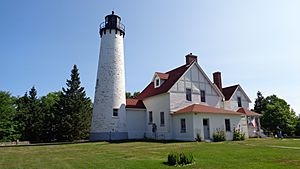Point Iroquois Light facts for kids
 |
|
| Point Iroquois Light (July 2018) | |
| Location | Whitefish Bay, Michigan |
|---|---|
| Coordinates | 46°29.021′N 84°37.541′W / 46.483683°N 84.625683°W |
| Year first lit | 1856 / 1870 |
| Automated | 1962 |
| Deactivated | 1971 |
| Foundation | Cement |
| Construction | Brick |
| Tower shape | Frustum of a cone |
| Markings / pattern | White tower, black parapet and lantern |
| Height | 65 feet (20 m) |
| Focal height | 72 feet (22 m) |
| Original lens | Fourth-order Fresnel lens |
| Range | 13 nautical miles; 24 kilometres (15 mi) |
| Characteristic | flash every 30 seconds |
The Point Iroquois Light is a historic lighthouse located on a bluff in Chippewa County, Michigan. This important light marks the boundary between Whitefish Bay and the western part of the St. Marys River. This river connects Lake Superior to the other Great Lakes.
The area around the lighthouse is also called Point Iroquois. It was named after Iroquois warriors. In 1662, they were defeated there by the Ojibwe people. Native Algonkian people called this place "Nadouenigoning." This name means "Iroquois bone."
Contents
History of the Lighthouse Point
In 1620, French explorers Étienne Brûlé and Grenoble were the first Europeans to visit this area. After that, Point Iroquois became a well-known landmark. French explorers, fur traders, and missionaries all used it as a guide. Sault Ste. Marie was the first European settlement in what is now Michigan.
Building the First Lighthouse
In 1853, the United States Congress decided to build the first Soo Locks on the St. Mary's River. They also approved money for a lighthouse at Point Iroquois. In 1855 and 1856, the United States Lighthouse Board built this first lighthouse. It was made of wood and stone.
This first lighthouse started working on June 18, 1856. It was a 45-foot-tall (14 m) stone tower with a wooden top. It had a flashing white fourth-order Fresnel lens. Because it was built on the highest ground, its light was 63-foot (19 m) above the water. Ships could see its light from about 10 nautical miles (19 km; 12 mi) away. A home for the lightkeeper was also part of the building complex.
However, by 1867, only eleven years later, a government inspector questioned how well the lighthouse was built. This led to plans for a new, stronger lighthouse. After the American Civil War, the United States Lighthouse Board began building many new lighthouses on the Great Lakes.
The Second Lighthouse and Station
In 1870, the first lighthouse and its keeper's home were taken down. The second and current Point Iroquois Light was then built. This new lighthouse cost about $18,000. This Cape Cod style white brick lighthouse worked for 93 years. It helped guide ships safely in and out of the Soo Locks.
The tower is 65-foot (20 m) tall. Its light is about 68 or 72 feet (21 or 22 m) above the water. The new lighthouse and its keeper's homes became important parts of the nearby lumber town of Brimley, Michigan.
Lighthouse Buildings and Features
In 1885, a bell tower was added. It had a machine that automatically rang a bell. In 1890, this bell tower was removed. A new building for a fog signal was built instead. This building had steam whistles to warn ships in foggy weather. In 1926, these were replaced with modern diaphone fog horns.
In 1905, a two-story addition was built onto the keeper's home. This provided living space for another assistant keeper. At its busiest, the station had a Head Keeper and two Assistant Keepers. The children of the keepers and local fishermen even had their own school on the grounds for a while. Other buildings at the site included: an assistant keeper's quarters, a fog signal building (which is now gone), three barns, a chicken house, a boat house, an oil house, an outhouse, and a well house.
When the Light Turned Off
The Point Iroquois Light stopped working in 1962. It was replaced by the Canadian-operated Gros Cap Reefs Light. This was an unmanned buoy-type beacon in the St. Marys River channel.
In 1993, the lighthouse and its living quarters were fully repaired and updated. In 1975, the Point Iroquois Light was added to the National Register of Historic Places. It is also on Michigan's state list of historic sites.
Point Iroquois Light Today
Today, the Point Iroquois Light is a famous landmark. It has even been featured on souvenirs.
The land and lighthouse are now part of the Hiawatha National Forest. The lighthouse itself is a Marine Museum. The Bay Mills/Brimley Historical Research Society helps with its restoration. They also manage the site.
In 1963, the original lens from the lighthouse was sent to the Smithsonian Institution. A different fourth-order Fresnel lens, taken from Martin Reef Light, is now on display inside the lightkeeper's house.
The museum has one apartment furnished to show how lightkeepers lived every day. Other rooms teach about lighthouse technology, the history of navigation tools, and show old photos. The double residence at the lighthouse now houses volunteers. These volunteers help with restoration work and give tours of the museum, gift shop, and tower.
- The tower and museum are open to visitors from Memorial Day through October 15. They are open seven days a week, from 10:00 a.m. to 5:00 p.m. On weekends (Friday through Sunday), they also reopen from 7:00 p.m. to 9:00 p.m.
- To get there, take M-221 into Brimley, Michigan. Then turn left onto 6 Mile Road. The lighthouse is about 7.5 miles (12.1 km) down that road.
See also
- Comet (steamboat)
- Lighthouses in the United States
- Great Lakes Storm of 1913
- Shipwrecks of the 1913 Great Lakes storm



